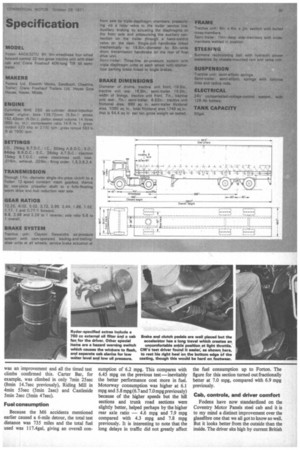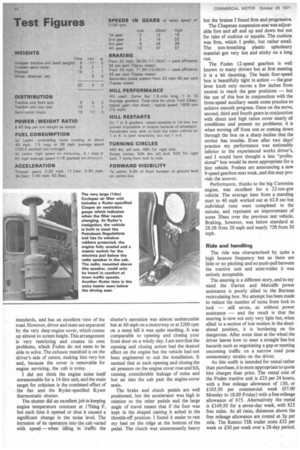Foden/Crane Fruehauf 32-ton-gtw attic
Page 79

Page 80

Page 81

Page 82

If you've noticed an error in this article please click here to report it so we can fix it.
by Gibb Grace,
DAuE, CEng, MIMechE WHEN we announced the intention of Ryder Truck Rental, of Miami, Florida, to enter the van and truck rental field in Britain (CM October 1) we also explained how the company's vast business in the USA (it owns 38,000 trucks and vans and 320 workshops) had been built up on the basis of "premium" vehicles built to Ryder specifications with a view to long, trouble-free life.
In keeping with this policy, on entering the UK market Ryder's first batch of sturdy 32-ton tractive units has been built by Foden with many detail features specified by the rental company, and we have recently tested one of the first of these Ryder Fodens over our full operational trial route.
The vehicle tested — coupled in this case to a 40ft Crane Fruehauf TIR Reritco trailer — was basically very similar to the model reported upon by CM in May this year (CM May 14), the biggest difference being in the engines fitted.
Both units had six-cylinder in-line Cummins engines, but whereas the first test vehicle had the NHK 205 producing 205 bhp gross at 2100 rpm and 560 lb.ft torque at 1500 rpm, the Ryder version had the larger NHK 250 B — but in derated form to give 220 bhp gross (212 bhp net) at 2100 rpm and, with 583 1b.ft at 1500 rpm, greater torque.
Both vehicles had the same 12-speed Foden splitter gearbox but the Ryder truck had a 5.8:1 driving axle ratio compared with the other's 6.2: 1. This difference looks minimal on paper but in fact turned out to be considerable on the road.
On the first day of our test the conditions proved abnormal. Road works and heavy traffic congestion increased the time taken from MIRA to the start of M6 by 10min, and our run between Keele and Charnock Richard service areas took 2hr 16min longer than on the earlier Foden test because we had to negotiate the aftermath of a multiple series of motorway accidents which had occurred in the fog that morning.
If we assume that the Ryder vehicle would have equalled the earlier Foden's running times over these sections which is reasonable the total running time for the first day works out at 9hr 12min an improvement of 16min. (This realistic adjustment is used in the summarized performance results see table.) On the second day traffic conditions were normal and the Ryder vehicle showed an improvement of 24min in covering the return route. Examining the figures more closely it becomes clear that most of the improvement was made on motorway sections where the higher axle ratio permitted a higher top speed and the extra power gave better performance on gradients.
On the trunk road sections, too, there was an improvement and all the timed test climbs confirmed this. Carter Bar, for example, was climbed in only 7min 25sec (8min 14.7sec previously), Riding Mill in 4min 53sec (5min 2sec) and Castleside 5min 2sec (5min 47sec).
Fuel consumption
Because the M6 accidents mentioned earlier caused a 6-mile detour, the total test distance was 735 miles and the total fuel used was 117.4gal, giving an overall con
sumption of 6.2 mpg. This compares with 6.45 mpg on the previous test-inevitably the better performance cost more in fuel. Motorway consumption was higher at 6.1 mpg and 5.8 mpg (6.7 and 7.0 mpg previously) because of the higher speeds but the hill sections and trunk road sections were slightly better, helped perhaps by the higher rear axle ratio 4.6 mpg and 7.9 mpg compared with 4.3 mpg and 7.8 mpg previously. It is interesting to note that the long delays in traffic did not greatly affect the fuel consumption up to Forton. The figure for this section turned out fractionally better at '7.0 mpg, compared with 6.9 mpg previously.
Cab, controls, and driver comfort Fodens have now standardized on the Coventry Motor Panels steel cab and it is to my mind a distinct improvement over the glassfibre one that we all got to know so well. But it looks better from the outside than the inside. The driver sits high by current British standards, and has an excellent view of the road. However, driver and mate are separated by the very deep engine cover, which comes up almost to screen height. This arrangement is very restricting and creates its own problems, which Foden do not seem to be able to solve. The exhaust manifold is on the driver's side of centre, making him very hot and, because the cover is removable for engine servicing, the cab is noisy.
I did not think the engine noise itself unreasonable for a 14-litre unit, and the main target for criticism is the combined effect of the fan and the Ryder-specified Kysor thermostatic shutter.
The shutter did an excellent job in keeping engine temperature constant at 170deg F, but each time it opened or shut it caused a significant change in the noise level. The intrusion of its operation into the cab varied with speed —when idling in traffic the shutter's operation was almost undetectable but at 60 mph on a motorway or at 2200 rpm on a steep hill it was quite startling It was comparable to opening and closing your front door on a windy day. 1 am sure that the opening and closing action had the desired effect on the engine but the vehicle had not been engineered to suit the installation. It seemed that at each opening and closing the air pressure on the engine cover rose and fell, causing considerable leakage of noise and hot air into the cab past the engine-cover seals.
The brake and clutch pedals are well positioned, but the accelerator was high in relation to the other pedals and the large angle of travel meant that if the foot was kept in the shaped casting it ached in the throttle-off position. I found it easier to rest my heel on the ridge at the bottom of the pedal. The clutch was unnecessarily heavy but the brakes I found firm and progressive.
The Chapman suspension seat was adjustable fore and aft and up and down but not for rake of cushion or squabs. The cushion was firm, which I prefer, but rather small. The non-breathing plastic upholstery material got very hot and sticky on a long run.
The Foden 12-speed gearbox is well known to many drivers but at first meeting it is a bit daunting. The basic four-speed box is beautifully tight in action — the gear lever knob only moves a few inches from neutral to reach the gear positions — but the use of this box in conjunction with the three-speed auxiliary needs some practice to achieve smooth progress. Once on the move, second, third and fourth gears in conjunction with direct and high ratios cover nearly all conditions and present no problems; it is when moving off from rest or coming down through the box on a sharp incline that the novice has trouble. Even after two days' practice my performance was noticeably inferior to the experienced works driver's, and I would have thought a less "professional" box would be more appropriate for a hire vehicle. Fodens are announcing a new 9-speed gearbox next week, and this may provide the answer.
Performance, thanks to the big Cummins engine, was excellent for a 32-ton-gtw vehicle. The average time from a standing start to 40 mph worked out at 62.8 sec but individual runs were completed in the minute, and represent an improvement of some 20sec over the previous test vehicle. Braking, however, was below standard at 38.5ft from 20 mph and nearly 72ft from 30 mph.
Ride and handling
The ride was characterized by quite a high bounce frequency but as there are little or no pitching and no push-pull between the tractive unit and semi-trailer it was entirely acceptable.
The steering is a different story, and to my mind the Davies and Metcalfe power assistance is poorly allied to the Burman recirculating box. No attempt has been made to reduce the number of turns from lock to lock — still seven, as without power assistance — and the result is that the steering is now not only very light but, when allied to a section of lost motion in the deadahead position, it is bordering on the dangerous. After some time at the wheel the driver learns how to steer a straight line but hazards such as negotiating a gap or meeting oncoming traffic on a narrow road pose unnecessary strains on the driver.
As this outfit is intended for rental rather than purchase, it is more appropriate to quote hire charges than price. The rental cost of the Foden tractive unit is £23 per 24 hours, with a free mileage allowance of 150, or £103.50 per commercial week (07.00 Monday to 18.00 Friday) with a free mileage allowance of 675. Alternatively the rental is £149.50 for a seven-day week, with 825 free miles. At all rates, distances above the free mileage allowance are costed at 5p per mile. The Rentco T1R trailer costs £32 per week or £30 per week over a 28-day period.












































































































































